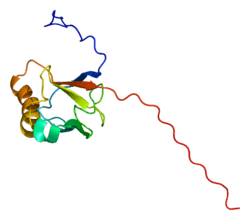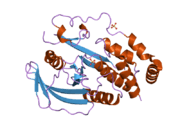PTPN4
Tyrosine-protein phosphatase non-receptor type 4 is an enzyme that in humans is encoded by the PTPN4 gene.[3][4]
Function
The protein encoded by this gene is a member of the protein tyrosine phosphatase (PTP) family. PTPs are known to be signaling molecules that regulate a variety of cellular processes including cell growth, differentiation, mitotic cycle, and oncogenic transformation. This protein contains a C-terminal PTP domain and an N-terminal domain homologous to the band 4.1 superfamily of cytoskeletal-associated proteins. This PTP has been shown to interact with glutamate receptor delta 2 and epsilon subunits, and is thought to play a role in signalling downstream of the glutamate receptors through tyrosine dephosphorylation.[4]
Interactions
PTPN4 has been shown to interact with GRID2.[5]
References
- ↑ "Human PubMed Reference:".
- ↑ "Mouse PubMed Reference:".
- ↑ Gu MX, York JD, Warshawsky I, Majerus PW (August 1991). "Identification, cloning, and expression of a cytosolic megakaryocyte protein-tyrosine-phosphatase with sequence homology to cytoskeletal protein 4.1". Proc Natl Acad Sci U S A. 88 (13): 5867–71. doi:10.1073/pnas.88.13.5867. PMC 51979
 . PMID 1648233.
. PMID 1648233. - 1 2 "Entrez Gene: PTPN4 protein tyrosine phosphatase, non-receptor type 4 (megakaryocyte)".
- ↑ Hironaka K, Umemori H, Tezuka T, Mishina M, Yamamoto T (May 2000). "The protein-tyrosine phosphatase PTPMEG interacts with glutamate receptor delta 2 and epsilon subunits". J. Biol. Chem. 275 (21): 16167–73. doi:10.1074/jbc.M909302199. PMID 10748123.
Further reading
- Gu M, Majerus PW (1996). "The properties of the protein tyrosine phosphatase PTPMEG". J. Biol. Chem. 271 (44): 27751–9. doi:10.1074/jbc.271.44.27751. PMID 8910369.
- Gu M, Meng K, Majerus PW (1996). "The effect of overexpression of the protein tyrosine phosphatase PTPMEG on cell growth and on colony formation in soft agar in COS-7 cells". Proc. Natl. Acad. Sci. U.S.A. 93 (23): 12980–5. doi:10.1073/pnas.93.23.12980. PMC 24032
 . PMID 8917530.
. PMID 8917530.
- Hironaka K, Umemori H, Tezuka T, Mishina M, Yamamoto T (2000). "The protein-tyrosine phosphatase PTPMEG interacts with glutamate receptor delta 2 and epsilon subunits". J. Biol. Chem. 275 (21): 16167–73. doi:10.1074/jbc.M909302199. PMID 10748123.
- Gjörloff-Wingren A, Saxena M, Han S, Wang X, Alonso A, Renedo M, Oh P, Williams S, Schnitzer J, Mustelin T (2000). "Subcellular localization of intracellular protein tyrosine phosphatases in T cells". Eur. J. Immunol. 30 (8): 2412–21. doi:10.1002/1521-4141(2000)30:8<2412::AID-IMMU2412>3.0.CO;2-J. PMID 10940933.
- Park KW, Lee EJ, Lee S, Lee JE, Choi E, Kim BJ, Hwang R, Park KA, Baik J (2001). "Molecular cloning and characterization of a protein tyrosine phosphatase enriched in testis, a putative murine homologue of human PTPMEG". Gene. 257 (1): 45–55. doi:10.1016/S0378-1119(00)00351-6. PMID 11054567.
- Stelzl U, Worm U, Lalowski M, Haenig C, Brembeck FH, Goehler H, Stroedicke M, Zenkner M, Schoenherr A, Koeppen S, Timm J, Mintzlaff S, Abraham C, Bock N, Kietzmann S, Goedde A, Toksöz E, Droege A, Krobitsch S, Korn B, Birchmeier W, Lehrach H, Wanker EE (2005). "A human protein-protein interaction network: a resource for annotating the proteome". Cell. 122 (6): 957–68. doi:10.1016/j.cell.2005.08.029. PMID 16169070.
PDB gallery |
|---|
|
| 2cs5: Solution structure of PDZ domain of Protein tyrosine phosphatase, non-receptor type 4 |
| 2i75: Crystal Structure of Human Protein Tyrosine Phosphatase N4 (PTPN4) |
|
|

 . PMID 1648233.
. PMID 1648233. . PMID 8917530.
. PMID 8917530.
